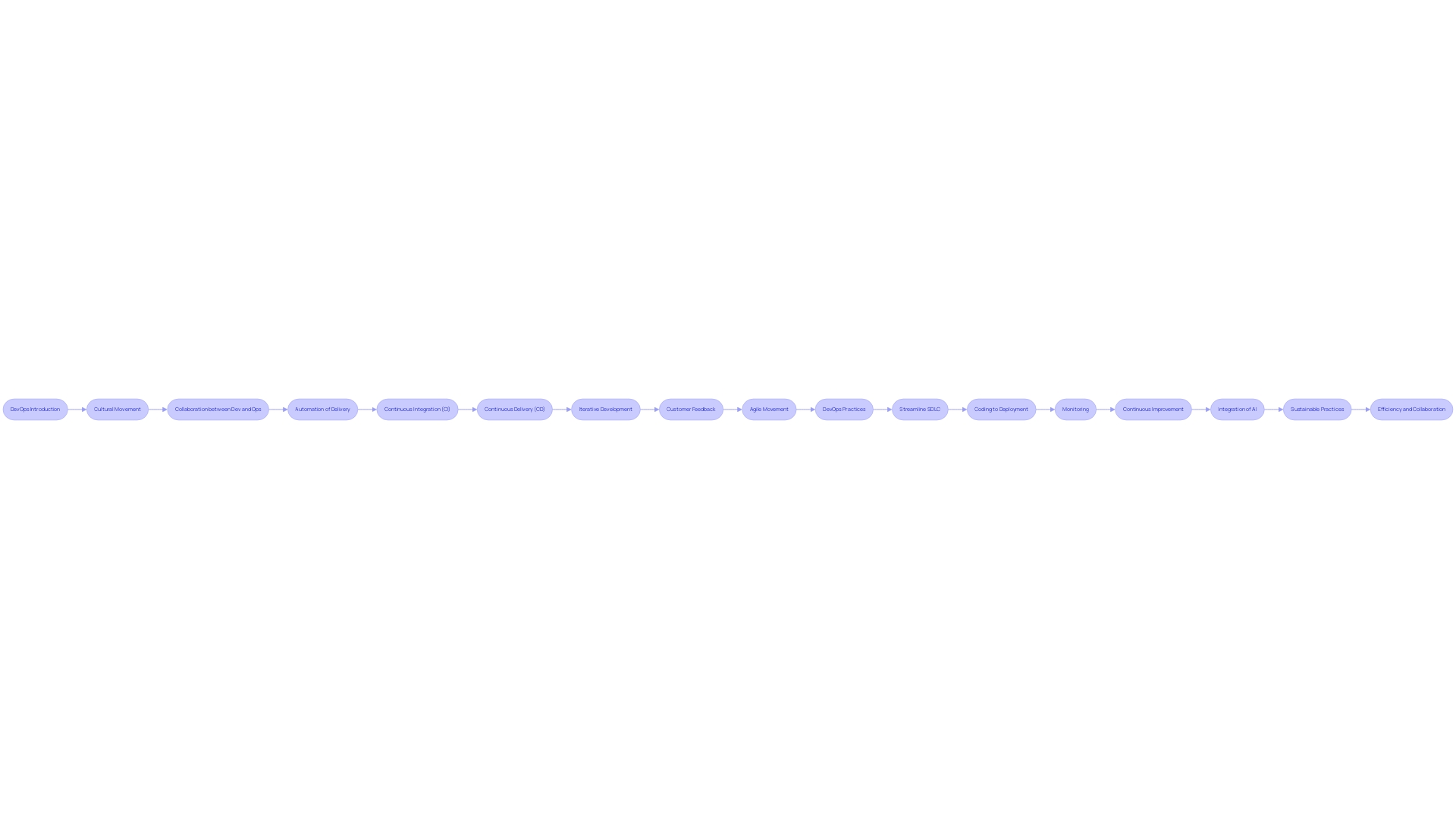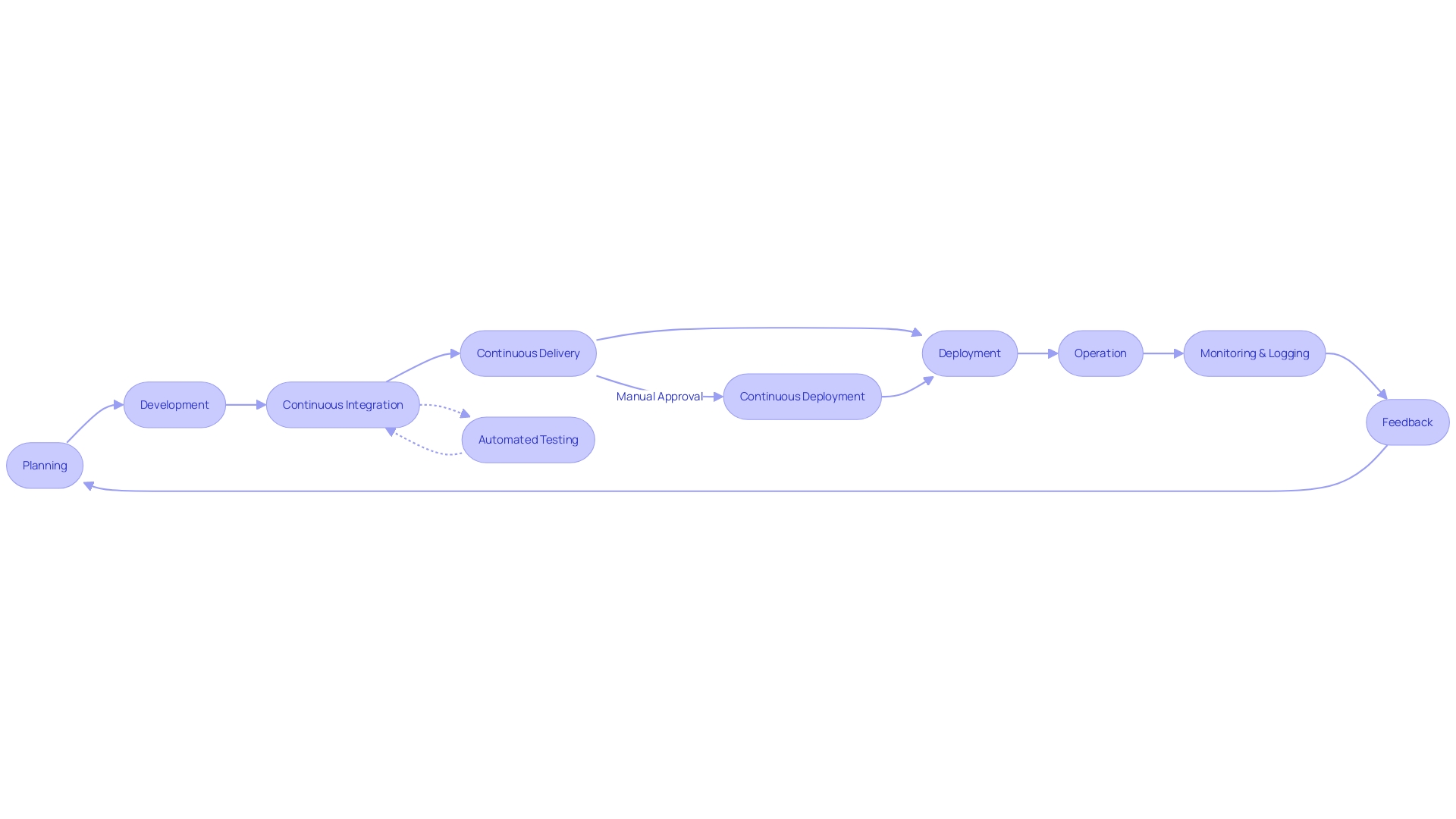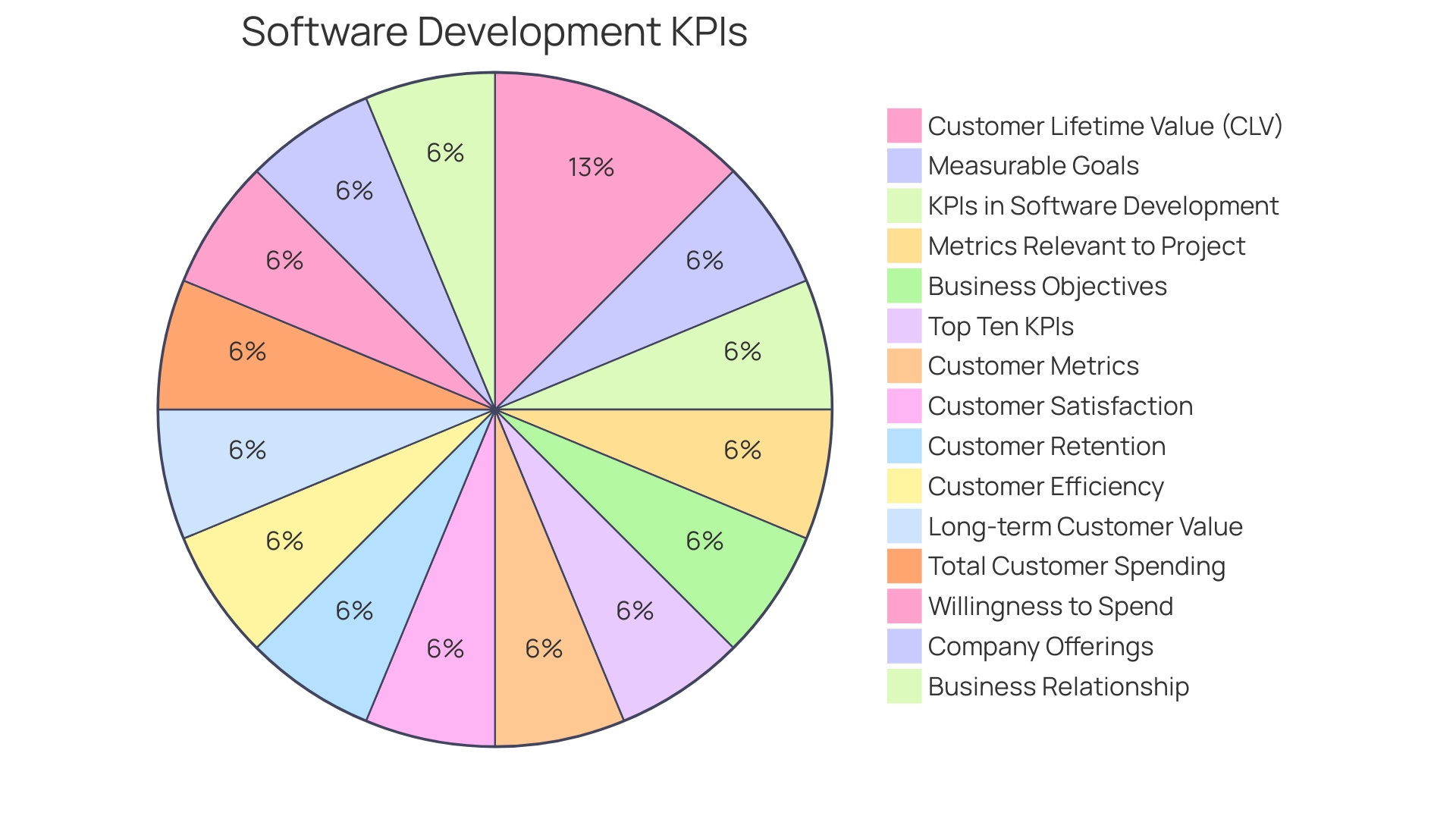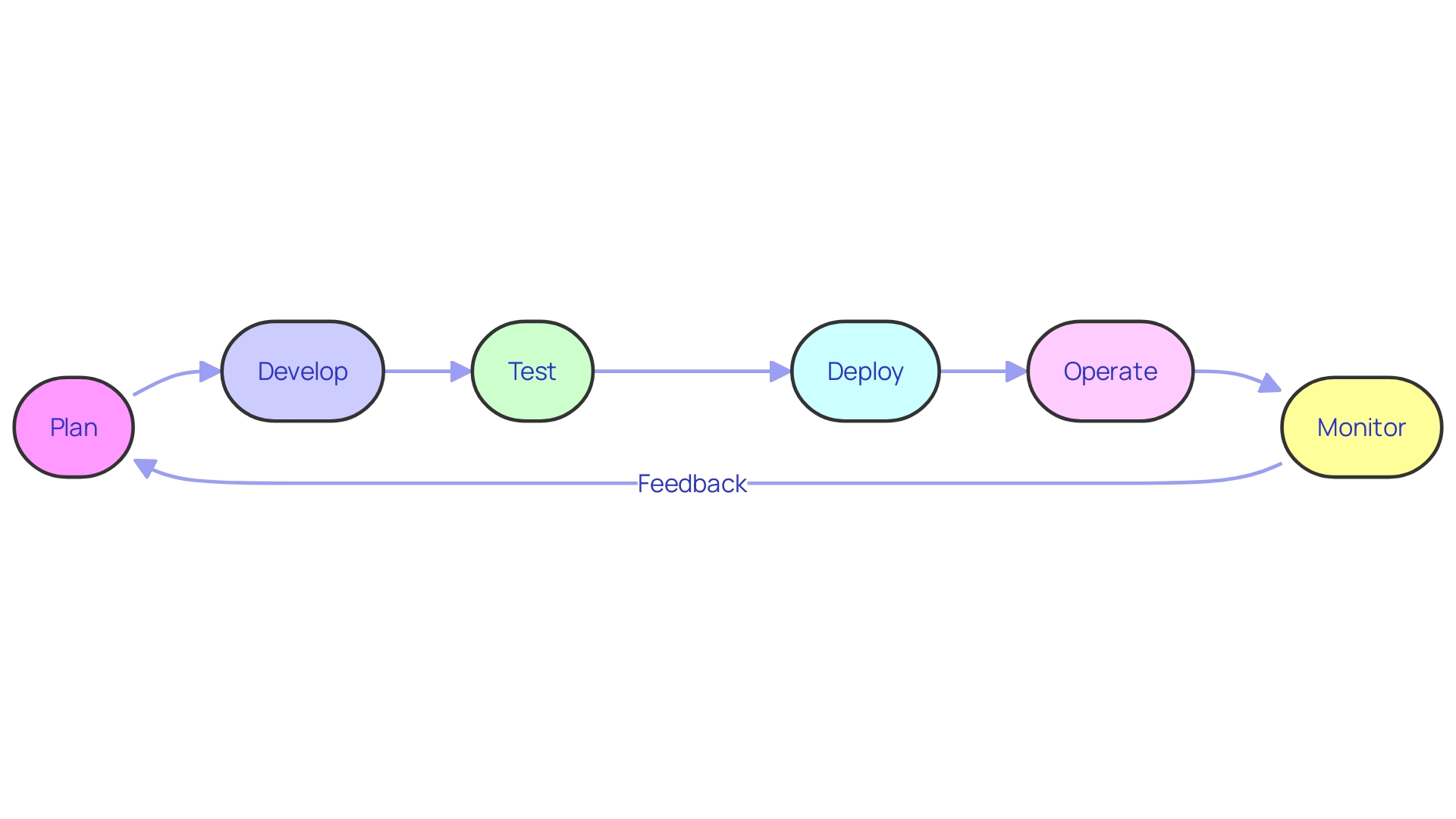Introduction
DevOps, the transformative methodology that merges software development and IT operations, has revolutionized the software development lifecycle. It breaks down traditional barriers between teams and fosters a culture of continuous improvement and communication. By integrating AI and embracing sustainable practices, DevOps has further enhanced its impact in the industry.
This article explores the key principles of DevOps, its culture and mindset, the automation of processes, the importance of measurement and feedback, continuous improvement, collaboration and communication, the DevOps lifecycle and phases, the benefits of adopting DevOps, daily DevOps practices, tools and technologies used in DevOps, and the challenges and best practices in implementing DevOps. Join us on this journey to uncover the immense value and potential that DevOps brings to the world of software development.
What is DevOps?
DevOps, an amalgamation of 'development' and 'operations,' is a transformative methodology that merges software development and IT operations to enhance collaboration and efficiency across the software development lifecycle. It shatters the traditional barriers between teams, fostering a culture where continuous improvement and communication are paramount. This approach is not just theoretical; it is rooted in real-world applications, such as the CI/CD process—an integral part of DevOps that enables seamless software delivery.
DevOps has gained recognition for its pivotal role in modernizing software development. It provides a responsive and synchronized development process, key to achieving high performance, customer satisfaction, and faster market release—all while maintaining cost-effectiveness. The transformative power of DevOps is evident in its approach to teamwork, where operations specialists and developers unite under the ethos 'We build it, we run it,' ensuring end-to-end ownership of the product life cycle.
The integration of AI in DevOps has furthered its impact. AI automates the build, test, and deployment phases, reducing errors and refining software quality, as noted by GitLab's analysis. AI also facilitates higher-level collaboration among development, operations, and business teams, as highlighted by Jeremy Rambarran of Touro University.
Moreover, the advent of GreenOps signifies DevOps' evolution towards sustainable practices, minimizing the carbon footprint of cloud environments. This innovative approach reflects the industry's commitment to not only efficiency but also environmental responsibility.
In essence, DevOps acts as a catalyst for stability and innovation in the workplace. It represents a shift from the waterfall model's rigidity to a dynamic and collaborative ecosystem, where quick adaptation to change is valued, and all team members are empowered to contribute to the software's success.

Key Principles of DevOps
DevOps, a union of development (Dev) and IT operations (Ops), has fundamentally transformed the software delivery process. It's a cultural and technical movement focused on collaboration and shared responsibility, aiming to enhance the speed and quality of software deployment. At its core, DevOps is about fostering a culture where development and operations teams work in close harmony, rather than in isolated silos. It breaks down barriers to improve communication, leading to more efficient and reliable software delivery.
Key DevOps principles include:
- Enhanced Collaboration: The traditional barriers between development and operations teams are dismantled, promoting an environment where knowledge, skills, and efforts are shared.
- Automation: By automating repetitive tasks such as software builds, testing, and deployment, DevOps reduces manual effort and the potential for errors, ensuring a smoother and faster delivery process.
- Continuous Improvement: DevOps is not static; it's a continuous cycle of refining and enhancing processes and tools. This commitment to evolution is critical for delivering better software and adding value to customers.
- Measurement and Feedback: Metrics and feedback loops are integral to DevOps, providing the insights needed for data-driven decision-making and pinpointing areas for advancement.
The DevOps lifecycle, often depicted as an infinity loop, encapsulates phases from planning to deployment, operation, and ongoing feedback. This symbolizes the continuous nature of DevOps, where improvement is perpetual and integral.
Recent statistics further underscore the efficacy of DevOps practices: 65% of organizations report higher quality deliverables, 52% experience faster recovery from failures, 48% see improved development of products and services, and 45% observe a lower rate of new release failures.
Implementing DevOps goes beyond merely adopting new tools; it's about embracing a mindset that values adaptability, teamwork, and technological growth. As highlighted by industry expert Patrick Dubois, the DevOps ethos is "We build it, we run it," emphasizing the full lifecycle ownership by the software delivery team, from development to production.

Culture and Mindset
Embracing DevOps is akin to the monumental task of constructing the Hoover Dam in the 1930s. Just as this colossal project brought together various specialists and required a culture of shared responsibility to overcome extreme challenges, DevOps necessitates a similar collaborative ethos. It involves dismantling traditional silos between development and operations teams to foster a customer-centric culture that thrives on transparency, trust, and collective accountability.
At the heart of DevOps lies a significant paradigm shift that champions embracing change, learning from setbacks, and pursuing continuous enhancement. This mirrors the lessons from the Hoover Dam's construction, where empowerment and trust were delegated to specialists, minimizing top management's direct involvement and allowing for innovative problem-solving approaches.
Moreover, recognizing the complementary nature of DevOps and Agile methodologies is crucial. As current trends indicate, these methodologies are revolutionizing software development worldwide by enhancing collaboration and developer efficiency. The synergy between DevOps' focus on bridging gaps and Agile's emphasis on development cycle efficiency presents a robust framework for organizations to accelerate their software delivery with improved quality and reliability.
Statistics from the Linux Foundation Research highlight the global adoption of cloud native computing, containers, and Kubernetes, underscoring the importance of DevOps in modern software development. With data from over 1,300 respondents, the insights affirm the movement's impact on various industries and company sizes, with a clear trend towards embracing these technologies for a competitive edge.
Furthermore, quotes from industry thought leaders reveal a critical understanding that, while DevOps has significantly shaped software development, it is not a panacea. It requires careful implementation to avoid centralizing risk and introducing new challenges.
In conclusion, the journey towards DevOps adoption is more than a set of practices; it's a transformative shift in culture and mindset, much like the pioneering spirit that built the Hoover Dam. It's about building a foundation of collaboration that enables teams to rise to the challenges of today's dynamic software development landscape.

Automation of Processes
DevOps, a cultural and professional movement that emerged in the late 2000s, represents a profound paradigm shift in software development, aiming for continuous improvement and rapid delivery of products. Crucial to this methodology is its reliance on automation to seamlessly integrate various stages of the software development lifecycle (SDLC), bridging the traditional divides between development, operations, and quality assurance. Automation within DevOps is not merely about deploying a set of tools—it embodies a mindset of shared responsibility, transparency, and ongoing enhancement.
The SDLC automation encompasses a range of standard practices, such as continuous integration (CI), continuous delivery (CD), infrastructure as code (IAC), configuration management, and monitoring. These automated processes are instrumental in achieving expedited delivery times and enhanced precision, aligning technical outcomes with overarching business objectives.
For instance, configuration management tools like Chef allow for the management of complex tasks and form an integral part of the infrastructure as code paradigm. Similarly, CI/CD tools have been pivotal in increasing speed and agility in software delivery, enabling businesses to quickly adapt to market changes while simultaneously improving software quality and reducing operational costs.
Moreover, recent developments in the field reveal a growing integration of AI and autonomous systems, such as the utilization of military robots for surveillance, indicating a trend towards the increasing sophistication of automation technologies.
It's also noteworthy that the adoption of DevSecOps, which integrates security into the DevOps process from the start, is on the rise. This approach is critical given the 21% increase in incidents impacting GitHub users in 2023, highlighting the need for robust security measures embedded within the development pipeline.
Ultimately, the essence of DevOps lies in fostering a culture of collaboration and automation, wherein repetitive tasks are streamlined, human error is mitigated, and a consistent environment is maintained across all phases of development, testing, and production. This leads not only to a reduction in overhead but also to an accelerated time to market, providing a competitive edge in today's dynamic tech landscape.
Measurement and Feedback
DevOps, the fusion of development and operations, is not just a set of practices but a cultural philosophy that hinges on a cycle of continuous improvement. To thrive in such an environment, organizations must establish robust metrics and feedback loops. These are the vital signs that indicate the health of software development and delivery processes.
Key Performance Indicators (KPIs) are essential in setting measurable goals for the software development life cycle (SDLC). They are not one-size-fits-all but should align with an organization's specific project and broader business objectives. For instance, KPIs can range from deployment frequency to change lead time, pointing towards the agility and efficiency of operations.
Capturing qualitative metrics, which provide context beyond quantitative data, is particularly crucial. These metrics illuminate the 'why' behind the 'how,' offering insights into the user experience and the value delivered through software solutions. As one industry expert puts it, focusing solely on developer productivity and the act of delivering software can detract from the ultimate goal of creating meaningful products.
Moreover, developer productivity has become a pressing concern amidst economic constraints and the advent of transformative technologies. With the right metrics in place, teams can pinpoint bottlenecks, gauge the effectiveness of changes, and optimize processes to enhance overall efficiency.
The practice of GreenOps, for example, is emerging as a response to consumer demand and regulatory pressures. It focuses on minimizing the carbon footprint of cloud environments by efficiently using cloud resources, reflecting a growing trend in performance metrics that extend beyond traditional measures to encompass environmental impact.
In essence, a data-driven approach to DevOps—supported by qualitative and quantitative metrics—enables informed decision-making and continuous improvement, ensuring that technology initiatives not only propel innovation but also align with the evolving landscape of business and societal expectations.

Continuous Improvement
DevOps culture pivots on the principle of continuous improvement, empowering organizations to enhance their tools, processes, and technologies in an iterative manner. This leads to consistent value delivery to customers and a competitive edge in the dynamic tech marketplace. A key aspect of this approach is fostering a culture that encourages experimentation, learning from setbacks, and utilizing feedback constructively for perpetual advancements.
M&T Bank's journey, with its roots dating back to 1856, exemplifies the digital transformation sweeping across the banking sector. The bank addressed the heightened security and regulatory demands by setting clean code standards for their development teams, thereby ensuring the maintainability and security of their software. Similarly, Bosch's innovation in sustainable energy through its SOFC system reinforced by a digital twin showcases the importance of continuous improvement and the use of digital tools for efficient, scalable solutions.
The convergence of DevOps and Agile methodologies is leading the charge in modern software development, as illustrated by their shared emphasis on collaboration and efficiency. By integrating principles like Continuous Integration and Continuous Delivery within their workflows, organizations can transcend the historical barriers between development and operations, as the Agile movement's early focus on iterative development and customer feedback laid the groundwork for DevOps.
However, the DevOps journey is not without challenges. As we navigate the complexities of software development, it's crucial to maintain a balanced approach that prioritizes both the developers' experience and the quality of the software they produce. This involves recognizing the impact of developer burnout and retention issues, and addressing them through an optimized work environment, as highlighted by the Developer Experience Lab. Continuous Integration research further emphasizes the need to understand the causal effects on software quality, ensuring that DevOps practices contribute positively to the overall development lifecycle.
Collaboration and Communication
The convergence of development and operations teams, under the DevOps umbrella, is pivotal for the seamless delivery of high-quality software. This union is akin to the harmonization of two distinct but complementary melodies, resulting in a symphony that accelerates the development cycle and enhances product quality. For instance, Bosch's utilization of a digital twin to support its solid oxide fuel cell (SOFC) system exemplifies the seamless integration of physical and digital engineering. This symbiosis enables real-time monitoring and optimization, showcasing the profound impact of collaboration on product lifecycle management and sustainability efforts.
Similarly, TotalEnergies Digital Factory (TDF) illustrates the centrality of APIs in modernizing legacy systems, embodying the essence of DevOps by ensuring that solutions are not only digitally transformative but also tailored to operational requirements across various regions. TBC Bank's agile transformation journey underscores the necessity of reducing organizational complexity, thereby enabling rapid digital product rollouts that align with customer and employee expectations.
In the context of DevOps, the cultural shift towards integrated teamwork is underlined by the sentiment, 'We build it, we run it,' underscoring the shared responsibility throughout the product's lifecycle. This approach, which mirrors agile's original intent, mandates an all-encompassing responsibility for quality and testing, transcending traditional deployment pipelines to include monitoring and observability.
The quest for a 'silver bullet' in DevOps is a pursuit of adaptability rather than a one-size-fits-all solution, recognizing that the dynamism of each project and team necessitates a bespoke approach. As we navigate through the complexities of cloud applications and infrastructures, initiatives like the Radius project serve as a testament to the ongoing evolution of DevOps practices.
Embracing the DevOps philosophy means acknowledging that shortcuts, often misconstrued as laziness, can be strategic efficiencies when they derive from thoughtful problem-solving. The aim is to identify the simplest yet most effective path to delivering software that meets the intricate balance of constraints, resources, and objectives. Thus, the synergy between development and operations is not just a theoretical ideal but a practical strategy that has been statistically linked to improved lead times, enhanced feedback mechanisms, and reduced change failure rates in the software development process.

DevOps Lifecycle and Phases
The DevOps model, a term coined in 2009, reflects a shift in software development that emphasizes collaboration and communication between developers and IT operations. This method streamlines the software development lifecycle, ensuring a faster and more efficient path from creation to deployment. The lifecycle itself is divided into distinct phases, each critical to the delivery of high-quality software.
-
Plan: This phase is the foundation, where project requirements and objectives are outlined. Here, teams strategize on the workflow, ensuring alignment with business goals and a clear path forward.
-
Develop: This is where the rubber meets the road - coding, testing, and integrating the software. It's a dynamic arena of constant iteration and collaboration, where developers turn ideas into tangible products.
-
Test: Rigorous testing is imperative to detect bugs and issues. This phase is about quality assurance, ensuring that the software not only works but meets the high standards expected in the competitive marketplace.
-
Deploy: The deployment phase is about putting the software into action. It involves packaging the software and rolling it out to the production environment, where it will be utilized by end-users.
-
Operate: Here, the software is in the hands of the users, and operations teams focus on maintaining its stability and performance. It's a critical phase for monitoring the application in the real world.
-
Monitor: Continuous monitoring is essential to collect data and analyze metrics. It allows teams to pinpoint areas for improvement, optimizing the system for better performance and user experience.
The DevOps approach is not a one-size-fits-all solution, but it offers a set of proven patterns and frameworks that enhance the development process. It's a methodology that supports the modern business imperative for rapid innovation, high-quality output, and customer satisfaction. As the landscape evolves, DevOps continues to be a key player in driving software development services toward increased efficiency and effectiveness.

Benefits of Adopting DevOps
DevOps adoption offers transformative benefits for organizations looking to enhance their software delivery processes. By integrating development and operations teams and practices, companies can achieve:
-
Faster Time-to-Market: Leveraging DevOps, businesses can significantly reduce the development lifecycle, allowing rapid delivery of features and updates, thereby staying ahead in competitive markets. M&T Bank, with over 165 years of banking history, has embraced this philosophy, streamlining their development process to meet the digital demands of the modern banking consumer.
-
Improved Collaboration: The collaboration between development and operations teams is a cornerstone of DevOps. It cultivates a culture of shared responsibility, improved communication, and aligned objectives, leading to a more harmonious and productive work environment.
-
Enhanced Quality: DevOps integrates continuous testing and feedback throughout the software development lifecycle, which not only elevates the quality but also the security of the software, a critical factor in industries like banking where M&T Bank operates.
-
Increased Efficiency: Automation is a key component of DevOps, eliminating tedious manual processes, minimizing errors, and speeding up the production cycle. This efficiency translates into cost savings and allows teams to focus on strategic tasks.
-
Scalability and Flexibility: DevOps practices provide the ability to scale and adapt swiftly to changing business needs. This flexibility is essential for organizations like M&T Bank, which must maintain a competitive edge in the fast-paced financial sector.
With DevOps, companies can move at the speed required for innovation, adapt to changing markets, and drive efficient business results while maintaining high software quality and security. It is a strategic approach that supports continuous improvement and operational excellence.

Daily DevOps Practices
DevOps is a transformative culture that merges development (Dev) and IT operations (Ops) into a cohesive process, leading to increased efficiency and productivity. Key practices in DevOps include:
-
Continuous Integration (CI): This practice revolves around the frequent merging of code changes into a central repository, which encourages committing code in small chunks more frequently. This mitigates integration conflicts and allows for immediate testing, significantly reducing the integration issues developers face.
-
Continuous Delivery (CD): CD is the automated counterpart to traditional software release processes. It empowers teams to deploy software swiftly and more consistently by automating the steps between code changes and production deployment. The ultimate aim is to create a release process that is predictable, routine, and with minimal manual intervention.
-
Infrastructure as Code (IaC): IaC allows teams to manage and provision infrastructure through code, rather than through manual processes. This approach ensures environments are repeatable and consistent, and greatly simplifies the scaling and management of infrastructure.
-
Monitoring and Logging: Vital for maintaining the performance and health of applications, monitoring and logging practices provide insights into the operational aspects. This enables teams to preemptively detect and respond to issues before they escalate into larger problems.
-
Incident Management: An effective incident management process is crucial for a prompt response to and resolution of any production disruptions. This process ensures that when incidents occur, they are dealt with efficiently and with minimal impact on the service quality.
Amidst these practices, security is an integral part of the DevOps lifecycle, often referred to as DevSecOps. It emphasizes the incorporation of security measures early in the development process, fostering a 'shift-left' approach that embeds security into every stage, ensuring the delivery of secure software and compliance with regulatory obligations.
The infinite loop of DevOps, often depicted as a figure-eight, represents the continuous cycle of planning, coding, building, testing, releasing, deploying, operating, and monitoring, with constant feedback loops for continuous improvement.
By adopting these DevOps practices, organizations can achieve a culture of collaboration and automation, which is essential for delivering high-quality software promptly and addressing the dynamic demands of the modern software development landscape.

Tools and Technologies in DevOps
DevOps embodies a collaborative approach to software development and IT operations, leveraging a suite of tools to enhance efficiency, reliability, and speed of delivery. Selecting the right tools is critical, as they must cater to the unique needs of each project and contribute to the overarching goal of seamless integration and delivery.
Version control systems like Git are indispensable, functioning as the foundation for modern software workflows. They enable tracking of code changes and collaborative work, essential for maintaining code integrity, especially as teams commit to the mainline multiple times a day to avoid conflicts and enable frequent testing.
In the realm of Continuous Integration and Continuous Deployment (CI/CD), automation tools such as Jenkins, Travis CI, and CircleCI are crucial. They streamline the process of building, testing, and deploying software, significantly increasing speed and agility, and improving software quality - a necessity for businesses aiming to outpace competitors and adapt swiftly to market shifts.
Configuration management tools, including Ansible, Puppet, and Chef, automate infrastructure provisioning and management, ensuring consistent environments across development, testing, and production. This automation not only reduces overhead but also aligns closely with business objectives by providing faster market delivery.
Containerization, popularized by Docker, revolutionized the deployment of applications by packaging them into lightweight, portable containers. This approach facilitates consistency across environments and is part of a broader trend toward microservices and cloud-native development.
Finally, cloud platforms such as AWS, Azure, and Google Cloud offer scalable infrastructure and a rich set of services, supporting DevOps by providing resources on-demand. This flexibility is paramount as organizations increasingly adopt AI/ML in their development processes and pursue a shift-left approach to security.
These tools are not a one-size-fits-all solution but rather components of an adaptive toolkit. Successful DevOps implementation hinges on understanding the role of each tool and integrating them into a cohesive workflow that meets the specific demands of the project at hand.
Challenges and Best Practices in Implementing DevOps
The journey towards DevOps adoption is paved with both opportunities and challenges, which can be navigated through strategic practices:
-
Cultural Shift: Moving to a DevOps culture demands more than just new tools; it requires a paradigm shift. Strong leadership support is pivotal in driving this cultural change, bolstering it with clear communication and a phased approach to adoption. It's essential to foster a culture that values collaboration, continuous improvement, and flexibility to adapt to new methods.
-
Modernizing Legacy Systems: Integration or modernization of legacy systems is a critical step in streamlining the DevOps workflow. This complex challenge can be addressed through meticulous planning and fostering collaborative efforts across departments. The goal is to build a cohesive environment that supports continuous integration and deployment, aligning with modern practices such as creating executable files from compiled languages like Java and .NET during the build stage.
-
Skills Enhancement: As technologies evolve, so must the skillsets of the teams that wield them. Investing in comprehensive training programs ensures that team members are adept at navigating the DevOps landscape, understanding the roles of various tools, and the metrics that define success. This upskilling is not a one-time event but an ongoing process that keeps pace with the industry's rapid advancements.
-
Security Integration: Embedding security and compliance into DevOps practices from the inception is non-negotiable. The rise of DevSecOps underscores the importance of converging development, operations, and security processes. With security breaches on the rise, as evidenced by a 21% increase in incidents impacting GitHub users in 2023, ensuring security measures are an integral part, not an afterthought, is crucial for safeguarding assets.
-
Commitment to Continuous Learning: An environment that champions continuous learning and experimentation is vital for staying ahead in the fast-paced tech industry. This approach allows teams to remain agile, responsive to changes, and ready to leverage new opportunities for improvement and innovation.
By embracing these best practices, organizations can effectively mitigate the challenges associated with DevOps adoption and set the stage for a transformation that aligns with their strategic objectives and desired outcomes.
Conclusion
DevOps has revolutionized the software development lifecycle, fostering a culture of continuous improvement and communication. By integrating AI and sustainable practices, it has further enhanced its impact in the industry.
The key principles of DevOps include collaboration, automation, continuous improvement, and measurement and feedback. It breaks down barriers between teams, automates repetitive tasks, and drives the refinement of processes and tools.
DevOps requires a cultural and mindset shift that values adaptability, teamwork, and technological growth. It encourages organizations to embrace change, learn from setbacks, and pursue continuous enhancement.
Automation plays a pivotal role in DevOps, streamlining the software development lifecycle and improving software quality and security. Measurement and feedback enable data-driven decision-making and alignment with evolving expectations.
The DevOps lifecycle consists of planning, development, testing, deployment, operation, and monitoring. Each phase is critical for delivering high-quality software.
Adopting DevOps offers benefits such as faster time-to-market, improved collaboration, enhanced quality, increased efficiency, and scalability. It supports continuous improvement and operational excellence.
Daily DevOps practices involve continuous integration, continuous delivery, infrastructure as code, monitoring and logging, and incident management. These practices foster collaboration, automation, and a data-driven approach.
DevOps relies on a suite of tools and technologies, such as version control systems, automation tools, configuration management tools, containerization, and cloud platforms. Selecting the right tools aligns with project needs and contributes to seamless integration and delivery.
Implementing DevOps comes with challenges, but strategic practices can help overcome them. A cultural shift, modernizing legacy systems, skills enhancement, security integration, and a commitment to continuous learning are among the best practices.
In conclusion, DevOps is a transformative methodology that enhances collaboration, efficiency, and reliability in software development. By embracing its principles, culture, automation, and continuous improvement, organizations can unlock the immense value and potential that DevOps brings to software development.




